Have you wondered how to go about designing a native garden from scratch? Here is a step-by-step guide to follow, as well as additional elements to consider as you go along.
Garden design process
Here are the steps to follow.
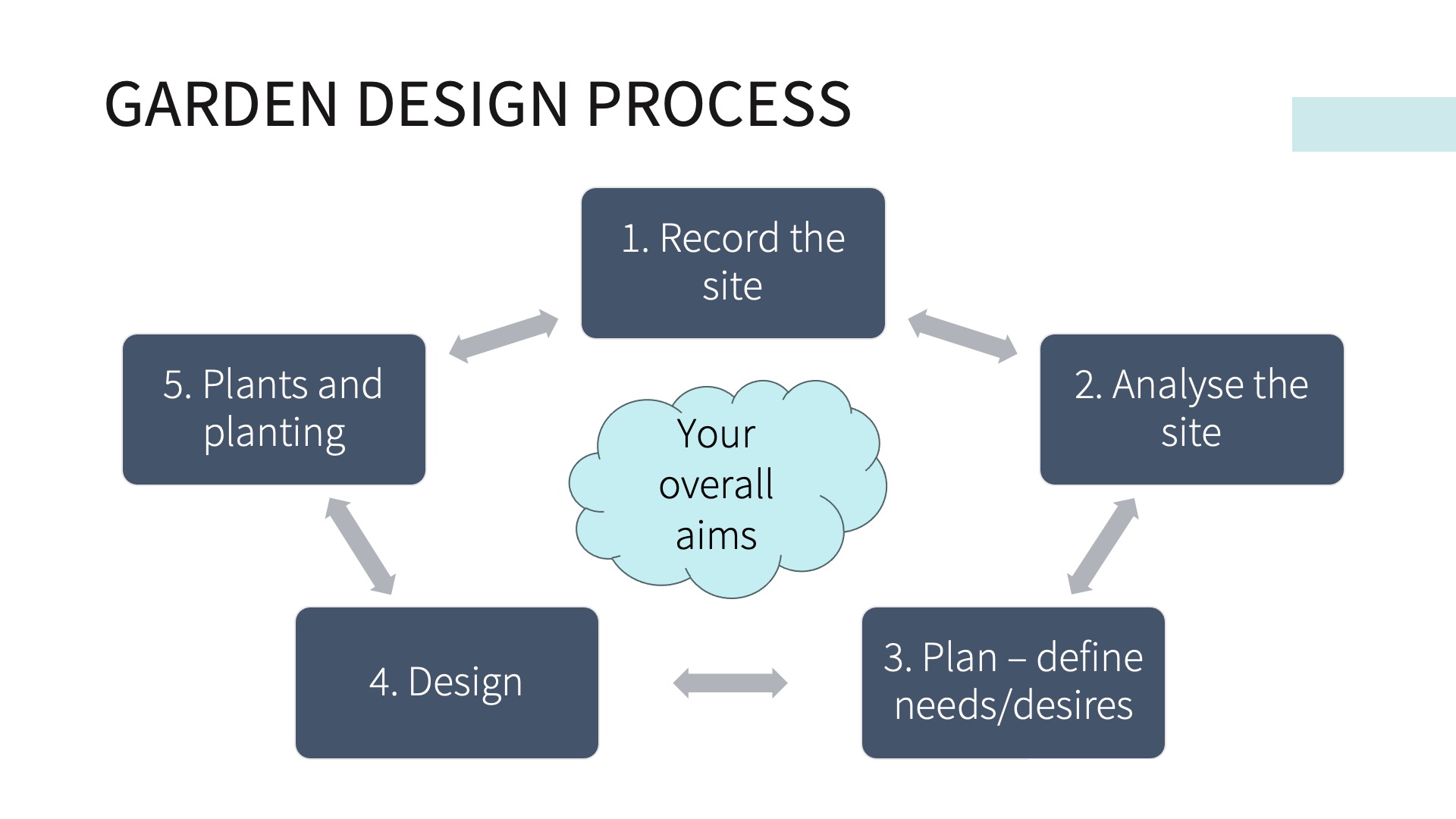
Before you start: Set high level aims
Before you get started, think about your overall aims for designing your native garden. What are you trying to achieve. e.g.
- Create habitat
- A walkabout garden
- Space for kids to play
At this stage, your high level aims are just that. Before anything can get locked down, you’ll have to full understand the site. Then you can revisit your aims in Step 3.
Step 1: Record the physical characteristics of your garden whether new or under rehabilitation.
- Prepare a layout plan showing the size and shape of your block . . .
- Most important – locate north!
- Indicate the slopes and levels
- Indicate the on-site and adjacent structures
- Show the underground and overhead services
- Define the landform, rock and soil patterns
- Locate existing vegetation for preservation
Here is an example of a simple layout plan.

If you have access to your house plans, that’s a good starting point. Or try Google Maps or Google Earth, which will give you a place to start designing your native garden.
Step 2: Get to know your site and its surrounds, personally.
- Illustrate on the layout plan the physical and microclimate impacts . . .
- Assess the patterns of sunshine and shadow
- Identify the effects of storm, wind, breeze
- Identify the effects of rainfall and water runoff
- Identify the positive and negative views
- Assess the quality of the soils and sub-soils
- Identify existing vegetation for preservation, transplant or removal
Here is a simple diagram to show how to think about Step 2. This one is analysing sun and shade.

Analysing your site in detail like this will assist you in designing your native garden.
Step 3: Identify your principal family needs and functions.
This next step is where it starts to be fun! Define on plan how YOU want to use the garden . . .
- Assess your budget, priorities and available time
- Plan for interesting arrival and first impressions
- Identify vehicle circulation requirements
- Plan functional and interesting access pathways
- Define and locate areas for outdoor living activities
- Plan for children’s play facilities
- Identify areas for work activities in the garden
Don’t forget – a garden is an artistic creation that evolves over time.
Here are some great examples of Step 3 from an old and but valuable book: Native gardens, How to create an Australian landscape, Bill Molyneux and Ross Macdonald, 1983. This book was written in conjunction with the Australian Plants Society.
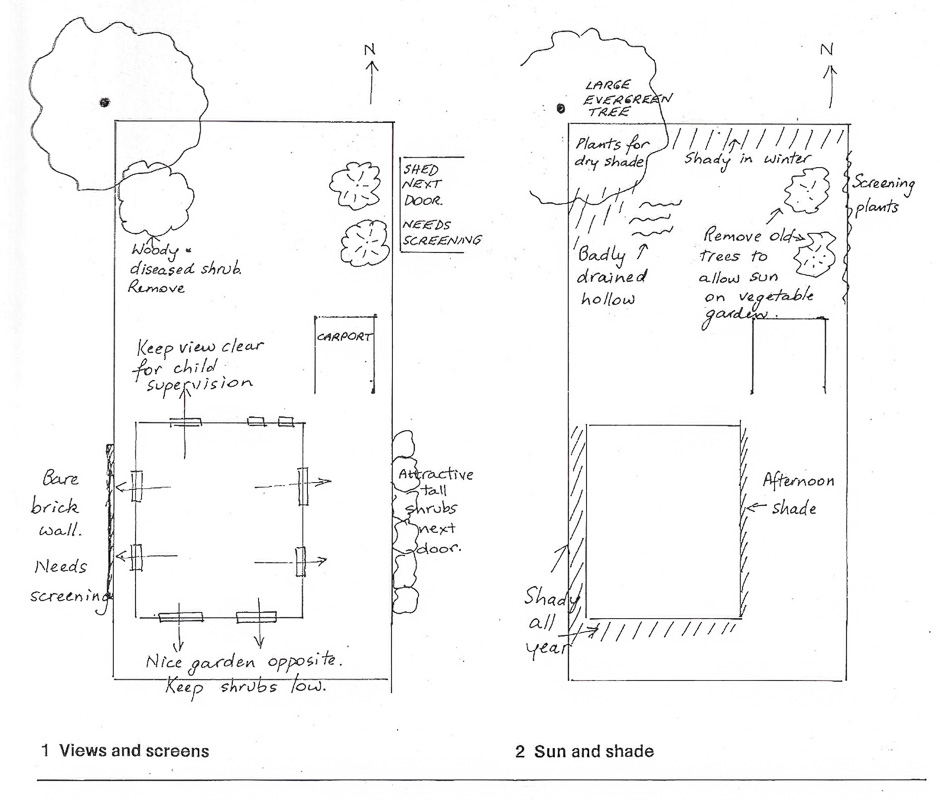

Step 4: Choose a style and theme for your garden.
Your preferred garden character will influence the site planning and plant selection. Is your garden to be…
- Formal, informal, traditional, contemporary or for seasonal horticultural display?
- Reflect the architectural style of the house?
- Exciting fusion of plants and materials
- Bush garden, rainforest, coastal, cottage or ?
- Collectors, scientific, experimental?
- ‘Walkabout’ or stroll garden?
- New fresh and uniquely Australian!
- Fundamentally simple, livable and affordable
In very simplified terms, you garden style might be formal, informal or wild/naturalistic.
Here is a short and admittedly simplified version of these three garden styles.
Formal gardens
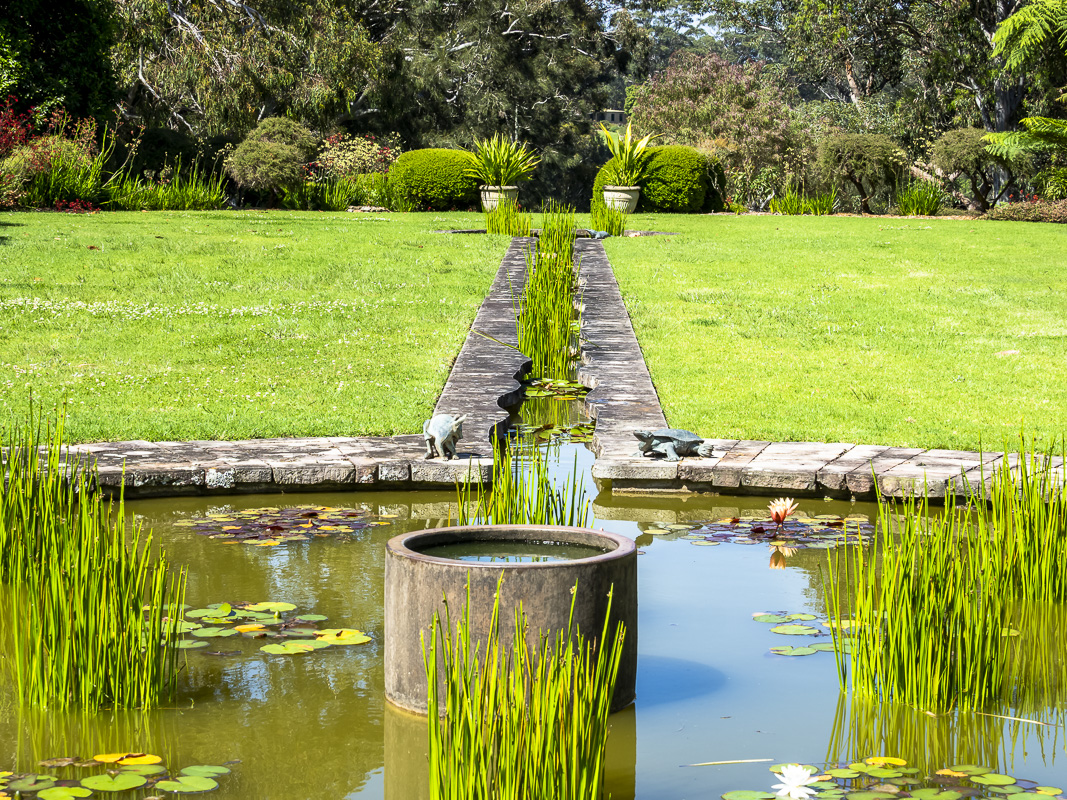
Horse Island on the south coast of NSW – a formal native garden. A formal garden typically has:
- Symmetrical/ geometric lines
- Proportion, scale and balance
- Focal points
- Paths
- Water
- Topiary, pruning
- Evergreen plants
- Restraint
- Static over time
- Essentially independent of the location
Informal gardens
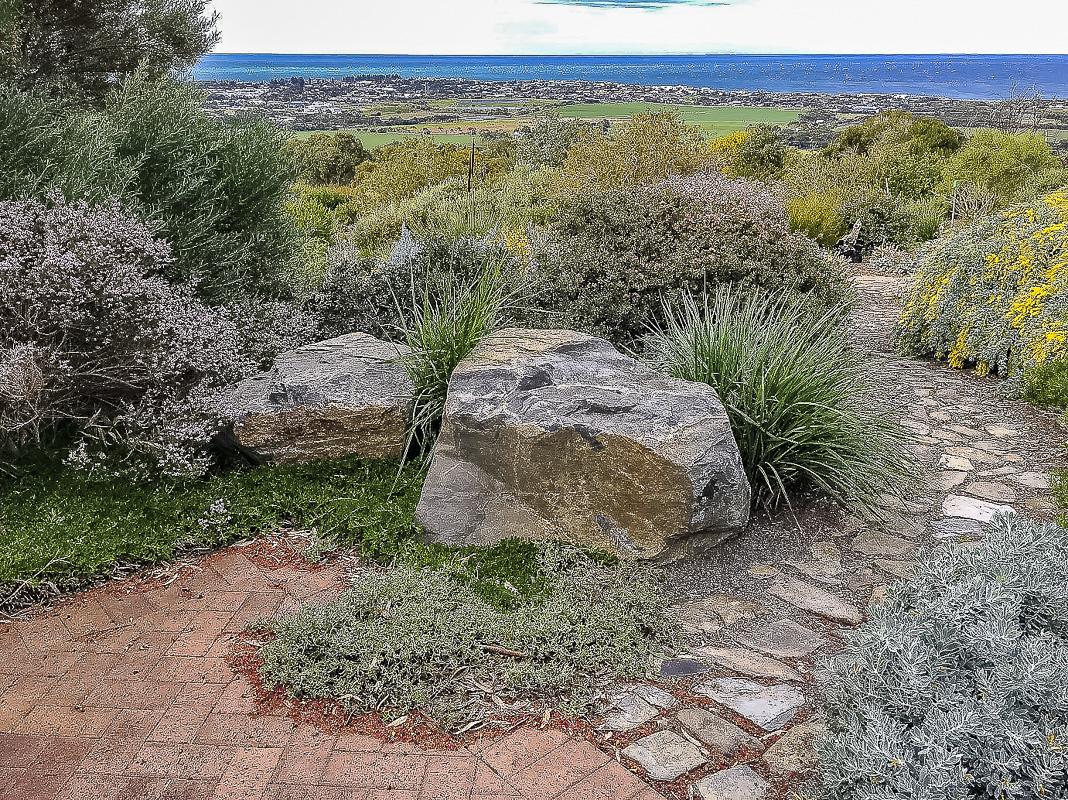
Baghurst garden in SA, image Judy Baghurst. Informal gardens typically have:
- Garden links to the landscape
- Changes over time, dynamic
- Asymmetric, curves
- Pruning for shape
- Plant masses
- Ornaments, rocks and water
- Seasonal colour
- Texture
- Some elements of formality (sometimes)
Wild/naturalistic garden

Australian Botanic Garden Mt Annan, image Heather Miles. A wild garden typically:
- Inspired by natural meadows and woodlands
- Diverse plant communities
- Indigenous species
- Plant groupings and layering – the matrix is what matters, not individual plants
- Changes over time
- Management not maintenance
Step 5: Now you are ready to select plants for your garden
Each plant has differing attributes . . .
- What is it? – tree, shrub, cover, vine, fern, palm or ?
- Where is it from?
- What conditions does it prefer?
- How big does it grow in nature?
- Does it adapt to horticultural techniques?
- Have you seen it thriving nearby?
- What is its most prominent feature – form, foliage, flowers, fruits, bark or ?
- Where are the most flowers and colourful foliage displayed and when?
More on selecting plants for better design of your native garden
Listen to the plants! They can tell you about themselves . . .
- Large leaves = shade tolerance
- Small leaves = sun preference
- Thick and waxy leaves = store water for later (water wise)
- Swollen trunk = store water (drought tolerant)
- Lignotubers = fire resistance
- Aromatic = insect resistance
- Massive seed production = weed potential
- Grey and silver leaves = sun tolerant and salt resistant
- Delicate leaves = moisture stress indicator
- Thorns and spines = wildlife protection and habitat
For more information about plants and their characteristics, see plant databases here:
Australian Plants Society NSW
Australian Native Plants Society Canberra
Trees

Trees have a variety of characteristics and functions
- Evergreen or deciduous
- Consider root systems
- Diverse forms: globular, upright, umbrella, irregular, weeping, conical, etc
- Specimen tree as a feature or focus element: form, foliage, bark, flower , fruit or fragrance
- Shade tree locate to control sunshine and shadow
- Multi planted as a grove, forest or windbreak
Palms and cycads

Palm fronds add a special and unique character to a garden.
- Size: tall, medium, low
- Self cleaning or persistent fronds
- Feather frond or palmate frond
- Individual specimens
- Formal avenues
- Informal groves
Shrubs

Shrubs fulfil some important design functions…
- Size: tall, medium, low
- Screens and hedges: privacy, conceal, windbreak, filter breeze
- Feature: form, foliage, flower, fruit, fragrance
- Shrubbery: foliage contrast, water zone
- Aesthetic: colour, texture
Groundcovers
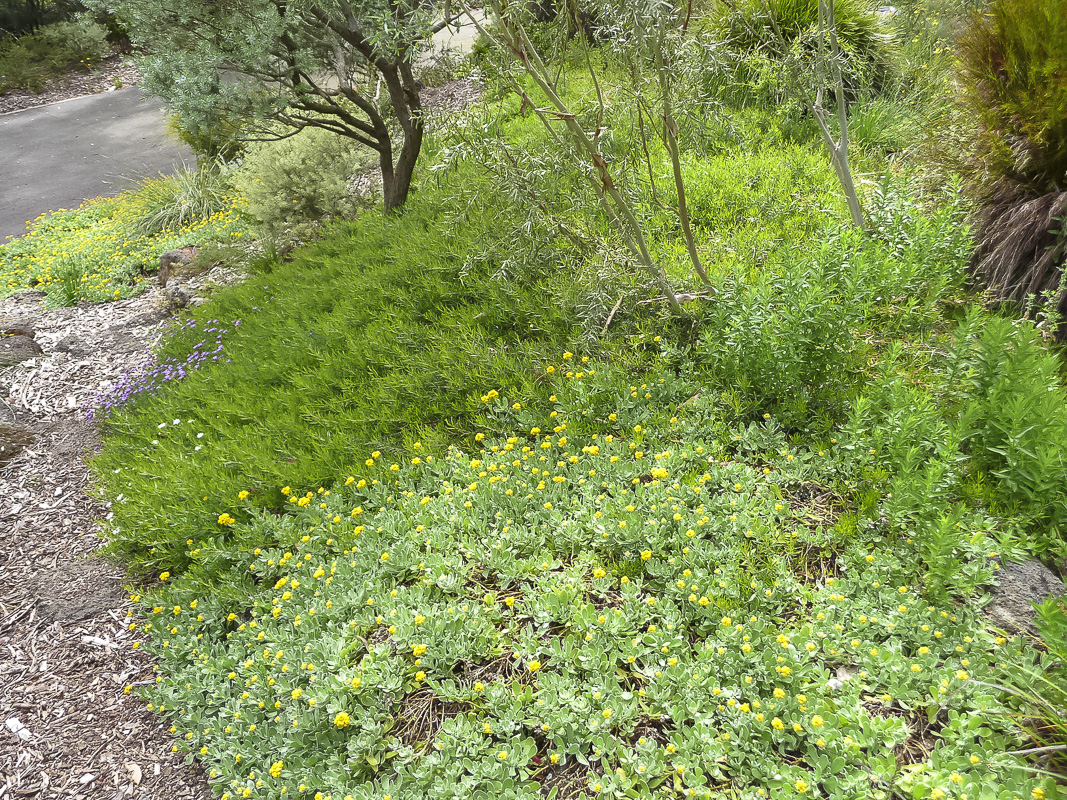
Groundcovers are diverse in colour, texture and form as well as functionally and structurally useful
- Dwarf shrubs, mattes, tufts, vines, scramblers, grasses, ferns
- Erosion control
- Living mulch
- Feature plants, seasonal colour
Vines
Vines are functionally and structurally useful…
- Select and locate to maximize flower display – over canopy, under canopy, along stems
- Shade and shelter: pergola and arbours
- Softening: fence, walls
- Maintenance: pruning, woody, fire, tree damage

Five basic planting techniques for designing your native garden
Garden layout and maintenance – to simplify and minimise water application
- Group plants with similar water needs together – Hydrozoning
- Shallow regular watering (unwise) – encourages roots to remain in the drier upper soil levels
- Deep soaking watering less often (wise) – draws roots down to permanent reserves of subsoil moisture
- Apply water deep down in the root zone through a slotted tube (wise) – to replenish subsoil reserves of moisture
Soil aeration, fertility, additives
- Amend soil texture to improve water absorption and aeration – add sand and organic material
- Use additives to lock applied moisture into soil so it is progressively available to plants
- Do not over fertilize and promote soft new growth – can you supply enough water to keep the plant alive?
Exposure – sun or shade, air movement
- Reduce exposure to sun and minimise moisture loss through transpiration
- Utilize available shade from house or trees to insulate plants from drying sun
- Protect plants from excessive air movement to inhibit loss of moisture from foliage
- Plant windbreaks and water-efficient shade trees to create cool shaded conditions
Landform – water runoff and harvesting
- Form suitable landform to collect surface water to absorb into subsoil and minimise runoff
Insulate the garden against the sun
- Mulch, mulch, mulch
- A minimum of 75-100 mm of mulch will insulate the soil like a blanket and conserve applied moisture
Here’s a PDF version of this planning and design process to help you along.
 Australian Native Plants Society (Australia)
Australian Native Plants Society (Australia)